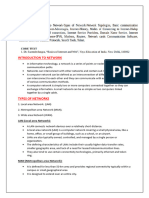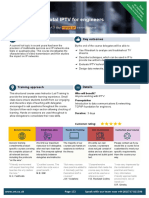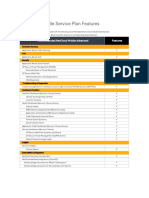0 ratings0% found this document useful (0 votes)
50 viewsComputer Network
A computer network connects two or more computers to share resources and information. There are different types of networks categorized by geographical location, including local area networks (LANs), metropolitan area networks (MANs), and wide area networks (WANs). Network topology refers to the layout of how devices are interconnected in a network. Common topologies include bus, star, and ring. Protocols define rules for communication between devices on a network. IPv4 and IPv6 are protocols that assign addresses to devices to enable communication over the internet. Networking devices like hubs, switches, bridges, and routers help manage traffic and connectivity within networks. The OSI model defines a standard framework for how data is transmitted between devices in layered network communication.
Uploaded by
Mamoon KhanCopyright
© © All Rights Reserved
Available Formats
Download as PDF, TXT or read online on Scribd
0 ratings0% found this document useful (0 votes)
50 viewsComputer Network
A computer network connects two or more computers to share resources and information. There are different types of networks categorized by geographical location, including local area networks (LANs), metropolitan area networks (MANs), and wide area networks (WANs). Network topology refers to the layout of how devices are interconnected in a network. Common topologies include bus, star, and ring. Protocols define rules for communication between devices on a network. IPv4 and IPv6 are protocols that assign addresses to devices to enable communication over the internet. Networking devices like hubs, switches, bridges, and routers help manage traffic and connectivity within networks. The OSI model defines a standard framework for how data is transmitted between devices in layered network communication.
Uploaded by
Mamoon KhanCopyright
© © All Rights Reserved
Available Formats
Download as PDF, TXT or read online on Scribd
You are on page 1/ 3
1
Paper: Computer Network:
QNo1: What is a computer network? Types of computer Network?
A compute
r network is a group of two or more computers connected with each other for sharing resources and information.
A simple computer network can be built only from two computers while a complex computer network can be built
from several thousand computers.
Types of computer network
A computer network can be categorized based on geographical location and characteristic. Based on geographical
location, computer networks are outlined below.
LAN (Local Area Network)
A LAN is a computer network which spans over a small geographical area such as home, building, office, etc. In
LAN, computers are placed relatively close. Since computers are located within small distance, they do not need
special devices and cables to connect with each other.
MAN (Metropolitan area networks)
A MAN is a computer network which connects two or more LAN networks within same city. When due to distance
connecting two LANs is not possible, MAN network is used. It is larger than LAN but smaller than WAN. It deploys
special devices and cables to connect the LANs.
WAN (Wide Area Network)
WAN is a computer network which spans over a large geographical area such as state, region, country etc. WANs
are typically used to connect two or more LANs or MANs which are located relatively very far from each other. To
provide connectivity, this network uses special devices, cables and technologies.
PAN (Pearson Area Network)
Same as LAN network, but it is limited to a specific person or location such as home network. This network is
usually setup for sharing resources such as internet and printer within personal computers.
QNo2. What is Topology? Types of network topologies discuss?
Network topology is the interconnected pattern of network elements. A network topology may be physical,
mapping hardware configuration, or logical, mapping the path that the data must take in order to travel around
the network.
There are many identified topologies but they are not strict, which means that any of them can be combined.
However, each topology has a different standard and may use different hardware methods so they are not
interchangeable.
Different Topology:
1. Network Topology
Computers in a network have to be connected in some logical manner. The layout pattern of the interconnections
between computers in a network is called network topology. You can think of topology as the virtual shape or
structure of the network. Network topology is also referred to as 'network architecture.'
2. Bus Topology:
Bus topology uses one main cable to which all nodes are directly connected. The main cable acts as a backbone for
the network. One of the computers in the network typically acts as the computer server. The first advantage of bus
topology is that it is easy to connect a computer or peripheral device. The second advantage is that the cable
requirements are relatively small, resulting in lower cost.
3. Star
In star topology, each computer is connected to a central hub using a point-to-point connection. The central hub
can be a computer server that manages the network, or it can be a much simpler device that only makes the
connections between computers over the network possible.
QNo 3. Define Media? Explain Wireless Communications Media?
Media is the plural form of medium, which (broadly speaking) describes any channel of communication. This can
include anything from printed paper to digital data, and encompasses art, news, educational content and
numerous other forms of information. Digital media, which makes up an increasingly vast portion of modern
communications, is comprised of intricately encoded signals that are transmitted over various forms of physical
and virtual media, such as fiber optic cable and computer networks.
Explain Wireless Communications Media
Wireless communications is a type of data communication that is performed and delivered wirelessly. This is a
broad term that incorporates all procedures and forms of connecting and communicating between two or more
devices using a wireless signal through wireless communication technologies and devices.
2
QNo4. Define Protocol:
A protocol is a set of rules and guidelines for communicating data. Rules are defined for each step and process
during communication between two or more computers. Networks have to follow these rules to successfully
transmit data.
QNo5.Short Note IPv4?
Internet Protocol version 4 (IPv4) is the fourth version of the Internet Protocol (IP). It is one of the core protocols
of standards-based internetworking methods in the Internet, and was the first version deployed for production in
[1]
the ARPANET in 1983. It still routes most Internet traffic today, despite the ongoing deployment of a successor
protocol, IPv6. IPv4 is described in IETF publication RFC 791 (September 1981), replacing an earlier definition (RFC
QNo6.Short Note IPv6?
Internet Protocol version 6 (IPv6) is the most recent version of the Internet Protocol (IP), the communications
protocol that provides an identification and location system for computers on networks and routes traffic across
the Internet. IPv6 was developed by the Internet Engineering Task Force (IETF) to deal with the long-anticipated
problem of IPv4 address exhaustion. IPv6 is intended to replace IPv4. In December 1998, IPv6 became a Draft
Standard for the IETF, who subsequently ratified it as an Internet Standard on 14 July 2017.
QNo7.
1. Explain Hub – A hub is basically a multiport repeater. A hub connects multiple wires coming from different
branches, for example, the connector in star topology which connects different stations. Hubs cannot filter data, so
data packets are sent to all connected devices. In other words, collision domain of all hosts connected through
Hub remains one. Also, they do not have intelligence to find out best path for data packets which leads to
inefficiencies and wastage.
2. Explain Bridge – A bridge operates at data link layer. A bridge is a repeater; with add on functionality of filtering
content by reading the MAC addresses of source and destination. It is also used for interconnecting two LANs
working on the same protocol. It has a single input and single output port, thus making it a 2 port device.
3. Explain Switch – A switch is a multi-port bridge with a buffer and a design that can boost its efficiency(large
number of ports imply less traffic) and performance. Switch is data link layer device. Switch can perform error
checking before forwarding data, that makes it very efficient as it does not forward packets that have errors
and forward good packets selectively to correct port only. In other words, switch divides collision domain of
hosts, but broadcast domain remains same.
4. Routers – A router is a device like a switch that routes data packets based on their IP addresses. Router is mainly
a Network Layer device. Routers normally connect LANs and WANs together and have a dynamically updating
routing table based on which they make decisions on routing the data packets. Router divide broadcast domains of
hosts connected through it.
5. NIC
Stands for "Network Interface Card" and is pronounced "nick." A NIC is a component that provides networking
capabilities for a computer. It may enable a wired connection (such as Ethernet) or a wireless connection (such
as Wi-Fi) to a local area network.
QNo8. DEFINE (OSI Model)? OSI Model Layers?
The Open Systems Interconnection (OSI) Model is a conceptual and logical layout that defines network
communication used by systems open to interconnection and communication with other systems.
The model is broken into seven subcomponents, or layers, each of which represents a conceptual collection of
services provided to the layers above and below it. The OSI Model also defines a logical network and effectively
describes computer packet transfer by using different layer protocols.
Network Layer
The network layer is the third level of the Open Systems Interconnection Model (OSI Model) and the layer that
provides data routing paths for network communication. Data is transferred in the form of packets via logical
network paths in an ordered format controlled by the network layer.
Session Layer
In the Open Systems Interconnection (OSI) model, the session layer is the fifth layer, which controls the
connections between multiple computers. The session layer tracks the dialogs between computers, which are also
called sessions. This layer establishes, controls and ends the sessions between local and remote applications.
Transport Layer
The transport layer is the layer in the open system interconnection (OSI) model responsible for end-to-end
communication over a network. It provides logical communication between application processes running on
different hosts within a layered architecture of protocols and other network components.
QNo: Local Area Network (LAN)
A local area network (LAN) is a computer network within a small geographical area such as a home, school, computer
laboratory, office building or group of buildings.
A LAN is composed of inter-connected workstations and personal computers which are each capable of accessing and sharing
data and devices, such as printers, scanners and data storage devices, anywhere on the LAN. LANs are characterized by higher
communication and data transfer rates and the lack of any need for leased communication lines.
3
QNo: Transmission Control Protocol/Internet Protocol (TCP/IP)
Transmission Control Protocol/Internet Protocol (TCP/IP) is the language a computer uses to access the internet. It
consists of a suite of protocols designed to establish a network of networks to provide a host with access to the
internet.
TCP/IP is responsible for full-fledged data connectivity and transmitting the data end to end by providing other
functions, including addressing, mapping and acknowledgment. TCP/IP contains four layers, which differ slightly
from the OSI model.
The technology is so common that one would rarely use the full name. In other words, in common usage the
acronym is now the term itself.
QNo9. PEER-TO-PEER (P2P)
Peer-to-peer (P2P) is a decentralized communications model in which each party has the same capabilities and
either party can initiate a communication session. Unlike the client/server model, in which the client makes a
service request and the server fulfills the request, the P2P network model allows each node to function as both
a client and server.
P2P systems can be used to provide anonymized routing of network traffic, massive parallel computing
environments, distributed storage and other functions. Most P2P programs are focused on media sharing and P2P
is therefore often associated with software piracy and copyright violation.
Typically, peer-to-peer applications allow users to control many parameters of operation: how many member
connections to seek or allow at one time; whose systems to connect to or avoid; what services to offer; and how
many system resources to devote to the network. Some simply connect to some subset of active nodes in the
network with little user control, however.
Although uses for the P2P networking topologies have been explored since the days of ARPANET, the advantages
of the P2P communications model didn't become obvious to the general public until the late 1990s, when music-
sharing P2P applications like Napster appeared. Napster and its successors -- like Gnutella, and more recently, Bit
Torrent -- cut into music and movie industry profits and changed how people thought about acquiring and
consuming media.
Server based network:
A Server based network can be defined as one where the majority of the traffic is between servers. This is actually
pretty typical of servers that serve the web. In their own data center, there is traffic between web servers, to and
from App servers, and to and from database servers. The clients are “Out there” on the web.
A client-server network might better describe a corporate environment, where the servers in the data center, are
directly connected to client PCs that are on their own network, maybe separated by a VLAN, but essentially,
everybody is under the same router.
QNo10. Define subneting? why subnetting is used?
A sub network or subnet is a logical subdivision of an IP network. The practice of dividing a network into two or
more networks is called subnetting. Computers that belong to a subnet are addressed with an identical most-
significant bit-group in their IP addresses.
The main purpose of subnetting is to help relieve network congestion. Congestion used to be a bigger problem
than it is today because it was more common for networks to use hubs than switches. When nodes on a network
are connected through a hub, the entire network acts as a single collision domain
QNo11: routing and routed protocol
Routed protocol: A routed protocol is a protocol by which data can be routed. Routed protocol are IP, AppleTalk,
and IPX. In this kind of protocols we require an addressing scheme and subnetting. Addressing scheme will be used
to determine the network to which a host belongs and to identifying that host on that particular network. All hosts
on an internetwork are using the services of a routed protocol. That means routers, servers, and workstations to.
The only two routed protocols that are in use today are IP and IPX but IPX is dropped from Cisco in exams and is
not in use much these days. If you are studying routed protocols the best advice is to focus on IP routed protocol.
Routing protocol: A routing protocol is different and is only used between routers. It makes possible for routers to
build and maintain routing tables. There are three classes of routing protocols- 1) distance vector, 2) link
state,3)hybrid
OSPF is one of two link state protocols, the other one is IS-IS. EIGRP is the only hybrid protocol but in normal
literature you will see that EIGRP is distance vector routing protocol.
You might also like
- Integrating Nokia Airscale Bts 5g To Netact 20181114 UpdateNo ratings yetIntegrating Nokia Airscale Bts 5g To Netact 20181114 Update59 pages
- Network Types of Types Network Topologies: Presented by Faiz Muhammad Roll No: 21 Muhammad Ishaque Roll No: 22No ratings yetNetwork Types of Types Network Topologies: Presented by Faiz Muhammad Roll No: 21 Muhammad Ishaque Roll No: 2222 pages
- 61bdbf24499f9 - Computer Network Note (1) byNo ratings yet61bdbf24499f9 - Computer Network Note (1) by13 pages
- An Assigenment On:-: 1. Basic of Networking 2. Introduction To Network Types 3. Internet and IntranetNo ratings yetAn Assigenment On:-: 1. Basic of Networking 2. Introduction To Network Types 3. Internet and Intranet8 pages
- Unit 9 Networking and Notworking by Min MyatNo ratings yetUnit 9 Networking and Notworking by Min Myat38 pages
- Network Basics: by Muhammad Arslan Farooq Mba-Itm (Iiui)100% (1)Network Basics: by Muhammad Arslan Farooq Mba-Itm (Iiui)44 pages
- STD VII - Lesson 1 - Computer Networking.No ratings yetSTD VII - Lesson 1 - Computer Networking.11 pages
- Unit 3 Computer Networking Class 12 (Aashi Nagiya)No ratings yetUnit 3 Computer Networking Class 12 (Aashi Nagiya)19 pages
- Presentation ON Network Topologies: Made By:-Praveen BhattNo ratings yetPresentation ON Network Topologies: Made By:-Praveen Bhatt34 pages
- Ch. No 1 Introduction to Computer Network pdfNo ratings yetCh. No 1 Introduction to Computer Network pdf20 pages
- computer network notes class 12 2023-24No ratings yetcomputer network notes class 12 2023-2414 pages
- Introduction to Internet & Web Technology: Internet & Web TechnologyFrom EverandIntroduction to Internet & Web Technology: Internet & Web TechnologyNo ratings yet
- Done CH 2 1st Year (Usman Sir) Computer MemoryNo ratings yetDone CH 2 1st Year (Usman Sir) Computer Memory16 pages
- Principal S Message: Govt, Degree College LatamberNo ratings yetPrincipal S Message: Govt, Degree College Latamber23 pages
- Brains Science School Latamber: His Been in OurNo ratings yetBrains Science School Latamber: His Been in Our1 page
- Performance-Comparison Testing of Ipv4 and Ipv6 Throughput and Latency On Key Cisco Router PlatformsNo ratings yetPerformance-Comparison Testing of Ipv4 and Ipv6 Throughput and Latency On Key Cisco Router Platforms25 pages
- F5 Pass4sureexam 101 v2019!02!20 by Donald 250qNo ratings yetF5 Pass4sureexam 101 v2019!02!20 by Donald 250q118 pages
- Product Management Suite: Audiocodes One Voice Operations CenterNo ratings yetProduct Management Suite: Audiocodes One Voice Operations Center36 pages
- Lks Nasional 2018 - Itnsa - Modulc - ActualNo ratings yetLks Nasional 2018 - Itnsa - Modulc - Actual24 pages
- 10: Icmpv6 Neighbor Discovery: Rick Graziani Cabrillo College Rick - Graziani@Cabrillo - EduNo ratings yet10: Icmpv6 Neighbor Discovery: Rick Graziani Cabrillo College Rick - Graziani@Cabrillo - Edu32 pages
- Iscom2828f Configuration Guide Rel - 01 PDFNo ratings yetIscom2828f Configuration Guide Rel - 01 PDF383 pages
- Website: Vce To PDF Converter: Facebook: Twitter:: H12-711.Vceplus - Premium.Exam.52QNo ratings yetWebsite: Vce To PDF Converter: Facebook: Twitter:: H12-711.Vceplus - Premium.Exam.52Q18 pages
- Mookambigai College of Engineering: Srinivasa Nagar, Kalamavur, Pudukkottai - 622502No ratings yetMookambigai College of Engineering: Srinivasa Nagar, Kalamavur, Pudukkottai - 62250235 pages
- Corinex Av200 Mdu Networking: Video, Voice, and Broadband Connectivity SolutionsNo ratings yetCorinex Av200 Mdu Networking: Video, Voice, and Broadband Connectivity Solutions34 pages
- Dns-Zone-Transfer:: Scripting Engine Notable ScriptsNo ratings yetDns-Zone-Transfer:: Scripting Engine Notable Scripts2 pages






























































































